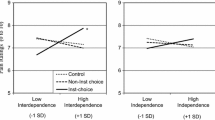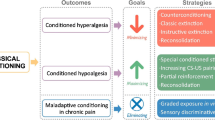Abstract
The ability of choice of treatments to enhance tolerance to pain was investigated. Results showed that subjects who were given a choice of coping strategies tolerated the cold pressor for a longer period of time than those not given a choice. The mechanism by which choice exerts its influence, however, remains unknown. In contrast to our predictions, having a choice of treatments did not increase perceptions of treatment credibility or a sense of self-efficacy. Post hoc analyses revealed that subjects who were not given a choice, but who were nevertheless assigned to their preferred treatment, did not differ from subjects given a choice on tolerance time, but reported less pain and found the treatment more credible than subjects given a choice. The mechanisms by which choice influences treatment outcomes, including the nature and role of treatment preferences, require further investigation.
Similar content being viewed by others
References
Avia, M. D., & Kanfer, F. H. (1980). Coping with aversive stimulation: The effects of training in a self-management context.Cognitive Therapy and Research, 4 73–81.
Bandura, A., & Adams, N. E. (1977). Analysis of self-efficacy theory of behavioral change.Cognitive Therapy and Research, 1 287–308.
Berntzen, D. (1987). Effects of multiple cognitive coping strategies on laboratory pain.Cognitive Therapy and Research, 11 613–624.
Borkovec, T. D., & Nau, S. D. (1972). Credibility of analogue therapy rationales.Journal of Behavior Therapy and Experimental Psychiatry, 3 257–260.
Council, J. R., Ahern, D. K., Follick, M. J., & Kline, C. L. (1988). Expectancies and functional impairment in chronic low back pain.Pain, 33 323–331.
Devine, D. A., & Fernald, P. S. (1973). Outcome effects of receiving a preferred, randomly assigned, or nonpreferred therapy.Journal of Consulting and Clinical Psychology, 41 104–107.
Festinger, L. (1957).A theory of cognitive dissonance. Stanford, CA: Stanford University Press.
Glasgow, R. E., Klepac, R. K., Dowling, J., & Rokke, P. D. (1982, November).Measures of self-efficacy in pain tolerance. Paper presented at the Annual Association for Advancement of Behavior Therapy Convention, Los Angeles.
Gordon, R. M. (1976). Effects of volunteering and responsibility on the perceived value and effectiveness of a clinical treatment.Journal of Consulting and Clinical Psychology, 44 799–801.
Grantham, R. J., & Gordon, M. E. (1986). The nature of preference.Journal of Counseling and Development, 64 396–400.
Horan, J. J., Hackett, G., Buchanan, J. D., Stone, C. I., & Demchik-Stone, D. (1977). Coping with pain: A component analysis of stress inoculation.Cognitive Therapy and Research, 1 211–221.
Kanfer, F. H., & Grimm, L. G. (1978). Freedom of choice and behavioral change.Journal of Consulting and Clinical Psychology, 44 373–376.
Keppel, G. (1982).Design and analysis: A researcher's handbook (2nd ed.). Englewood Cliffs, NJ: Prentice-Hall.
Kirsch, I. (1985). Response expectancy as a determinant of experience and behavior.American Psychologist, 40 1189–1202.
Klepac, R. K., Dowling, J., & Hauge, G. (1981). Sensitivity of the McGill Pain Questionnaire to intensity and quality of laboratory pain.Pain, 10 199–207.
Klepac, R. K., Dowling, J., & Hauge, G. (1982). Characteristics of clients seeking therapy for the reduction of dental avoidance reactions to pain.Journal of Behavior Therapy and Experimental Psychiatry, 13 293–300.
Klepac, R. K., Hauge, G., Dowling, J., & McDonald, M. (1981). Direct and generalized effects of three components of stress inoculation for increased pain tolerance.Behavior Therapy, 12 417–424.
Langer, E. J., & Rodin, J. (1976). The effects of choice and enhanced personal responsibility for the aged: A field experiment in an institutional setting.Journal of Personality and Social Psychology, 34 191–198.
Litt, M. D. (1988a). Cognitive mediators of stressful experience: Self-efficacy and perceived control.Cognitive Therapy and Research, 12 241–260.
Litt, M. D. (1988b). Self-efficacy and perceived control: Cognitive mediators of pain tolerance.Journal of Personality and Social Psychology, 54 149–150.
Manning, M. M., & Wright, T. L. (1983). Self-efficacy expectancies, outcome expectancies, and the persistence of pain control in childbirth.Journal of Personality and Social Psychology, 45 421–431.
Melzack, R. (1975). The McGill Pain Questionnaire: Major properties and scoring methods.Pain, 1 277–299.
Mendonca, P. J., & Brehm, S. S. (1983). Effects of choice on behavioral treatment of overweight children.Journal of Social and Clinical Psychology, 1 343–358.
O'Leary, A. (1985). Self-efficacy and health.Behaviour Research and Therapy, 23 437–451.
Rybstein-Blinchik, E. (1979). Effects of different cognitive strategies on chronic pain experience.Journal of Behavioral Medicine, 2 93–101.
Schulz, R. (1976). Effects of control and predictability on the physical and psychological well-being of the institutionalized aged.Journal of Personality and Social Psychology, 33 563–573.
Scott, D. S., & Barber, T. X. (1977). Cognitive control of pain: Effects of multiple cognitive strategies.The Psychological Record, 27 373–383.
Turk, D. C., Meichenbaum, D., & Genest, M. (1983).Pain and behavioral medicine: A cognitive-behavioral perspective. New York: The Guilford Press.
Vallis, T. M., & Bucher, B. (1986). Self-efficacy as a predictor of behavior change: Interaction with type of training for pain tolerance.Cognitive Therapy and Research, 10 79–94.
Worthington, E. L., Jr., & Shumate, M. (1981). Imagery and verbal counseling methods in stress inoculation training for pain control.Journal of Counseling Psychology, 28 1–6.
Author information
Authors and Affiliations
Additional information
Thanks to Paul Westerholm for his help in data collection. Special thanks to Russell Glasgow for his formative ideas on this topic, to James Council and Ruth Maki for their thoughtful input, and to those involved in the editorial and review process for their helpful comments. Portions of this paper were presented at the 1989 AABT Convention, in Washington, DC.
Rights and permissions
About this article
Cite this article
Rokke, P.D., Lall, R. The role of choice in enhancing tolerance to acute pain. Cogn Ther Res 16, 53–65 (1992). https://doi.org/10.1007/BF01172956
Issue Date:
DOI: https://doi.org/10.1007/BF01172956




